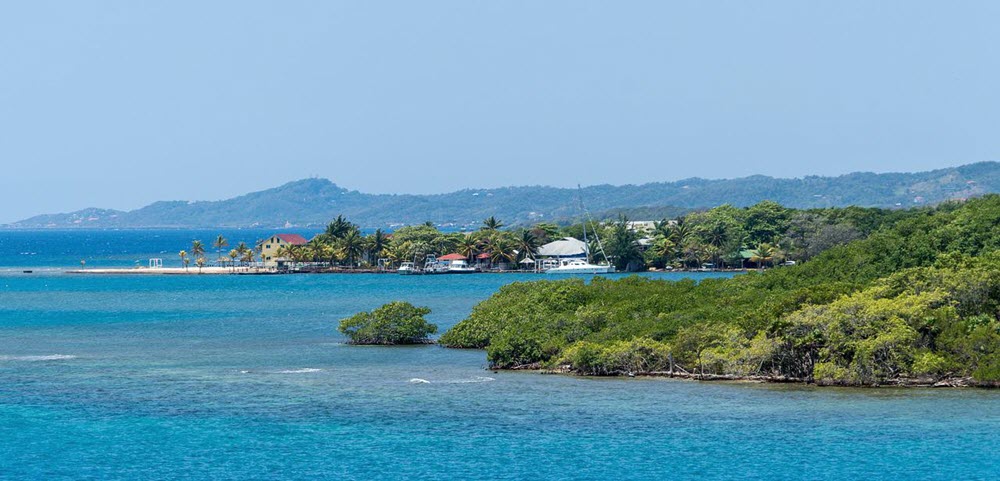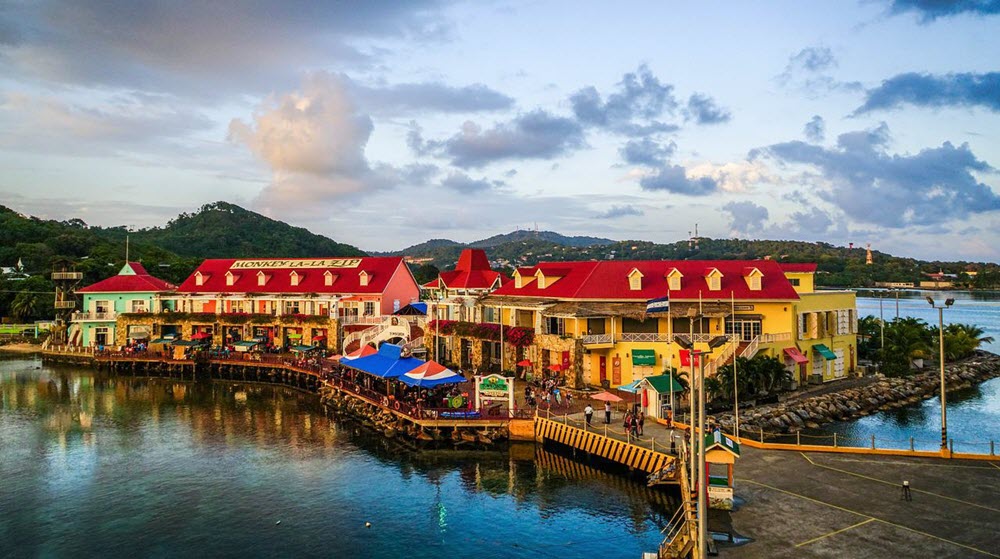The popular beach life, eco-tourism and scuba diving destination Roatán is a Caribbean located roughly 65 kilometres from the northern coast of the Honduran mainland, between the island Útila and Guanaja. Roatán is the largest of the Bay Island of Honduras. In older texts about Roatán, you may encounter the spellings Ruatan and Rattan.
Roatán is found near the Mesoamerican Barrier Reef, which is the largest barrier reef in the Caribbean Sea and the second-largest in the whole world (only the Great Barrier Reef in Australia is longer). The island itself rests on an exposed ancient coral reef. The easternmost quarter of the island is separated by a channel which runs through mangroves. On average, the channel is 15 metres wide.
The reef is home to stunning underwater creatures and also frequented by more nomadic marine animals – including whale sharks. Unsurprisingly, Roatán is renowned for its scuba diving and home to numerous dive schools. The island also have a number of sandy beaches, all of which are public.
Most of the inhabitants on Utila live on the western half of the island, and this is also where you find Coxen Hole, which is Utila´s most populous town.

How big is Roatán?
Roatán covers 83 square metres. It is an elongated island; roughly 77 km long, but less than 8 km across at its widest point.
Weather
Roatán is a tropical island and enjoys daytime temperatures in the 25-30 degrees C range on most days, year round.
The hurricane season is mid-September to early November, although the island is outside the most dangerous hurricane belt in the Caribbean and is usually spared from direct hits.
The rainy season is between October and January, with November and December being the rainiest months.
In January and February, expect northerly storms.
Short facts about Roatán
Location: Caribbean Sea
Archipelago: Bay Islands of Honduras
Coordinates: 16°23′N 86°24′W
Highest point: 221 metres
Population: 110,000 (year 2020)
Largest city: Coxen Hole
Time zone: Central Standard Time all year (GMT−6)
Airport
Juan Manuel Gálvez International Airport (Spanish: Aeropuerto Internacional Juan Manuel Gálvez) is located on Roatán.
- IATA: RTB
- ICAO: MHRO
Domestic flights are available from Puerto Lempira (PEU), Tegucigalpa (TGU), and San Pedro Sula (SAP).
The airport is served with year-round non-stop international flights from Houston, Atlanta, Dallas/Fort Worth, Miami, New York City (Newark International Airport), Minneapolis/St. Paul, San Salvador (in El Salvador), and Milan.
During the winter months (the main tourist season), the airport receives regular international flights from Montreal and Toronto, and there are also charters coming in from various locations.
Ferries
- The Galaxy Wave Ferry has service to the city of La Ceiba on the mainland twice a day.
- The Utila Dream ferry has a daily service from Roatan to the island Utila and to La Ceiba on the mainland.
Busses
There are direct busses from Guatemala city (Guatemala), San Salvador (el Salvaador) and Managua (Nicaragua) to the Roatan ferries.
Settlements
Here are a few examples of settlements on Roatán.
Coxen Hole
This is the largest town on Roatán and also where the international airport is located. Coxen Hole is the centre for banks, major stores, etcetera.
West Bay
West Bay is on the far west of the island and has become a popular vacation spot due to its powdery white sand beach. Nowadays, several large resorts are found there. The reef is only a short swim away, which is great news for snorkellers.
West End
Chiefly known for its bars and restaurants, but also have accommodation. Fun nightlife, often with live music. Many dive shops are located in West End.
Sandy Bay
This is chiefly a residential area, but a few resorts are located here as well, alongside dive shops and restaurants. Several non-profit organisations for the community are based in Sandy Bay, and some of them welcome volunteers. Examples are Clinica Esperanza, SandCastle Library, and Care4Communities.
Carambola Botanical Gardens cover 40 acres of land and have several jungle trails that are excellent for hiking, nature photography, and bird watching.
French Harbour
French Harbour, which have several popular restaurants, is located roughly 10 km east of Coxen Hole, and many tourists never venture further east than this when visiting Roatán.

Punta Gorda
This is a fishing community where a majority of the population are Garifuna. Garifuna is a mixed African and Caribbean indigenous (Arawak, Kalinago) people that developed on Saint Vincent.
Jonesville
If you are in the mood to explore east of French Harbour, one example of an interesting destination is Jonesville. From Jonesville, you can take a small water taxi to reach the Hole-in-the-Wall restaurant.
Oak Ridge
This is a fishing community on the eastern side of Roatán where the brightly coloured houses are built on stilts over the water. The aforementioned Hole-in-the-Wall restaurant is accessible by water taxi from here.
Camp Bay
Camp Bay Beach, located slightly more than 7 km from Oak Ridge, is largest natural beach on Roatán. It is possible to take a taxi to Camp Bay, but beyond Camp Bay the roads stop and the mangrove starts.
Port Royal
Port Royal, on the northern side of the island, is known for its historical association with piracy.
Language
While mainland Honduras have Spanish as the majority language, the situation is different in the Bay Islands. English is the majority language on Roatán, with Spanish being the second most widely spoken one.
English-speaking populations of mixed European and British-Afro-Caribbean descent have been established in Northern Honduras – including the Bay Islands – since the 1800s. There has been, and still is to some extent, a noticeable rivalry between them and the Spanish-speaking Hondurans living in the same region. “Caracoles” (the Spanish word for snails) is a Spanish-speaking offensive term for the English-speaking European-British-Afro-Caribbean peoples here.
In the 21st century, the use of Spanish on Roatán has increased, as the growing tourism sector has attracted mainland Hondurans to move to the island for work. Still, many of those who have Spanish as their native tongue also speak English and speaking at least basic English continues to be a requisite for many tourist-facing jobs on Roatán.
Nearby destinationes
Other popular island destinations includes Corn island, Nicaragua and Cocos island, Costa Rica.
